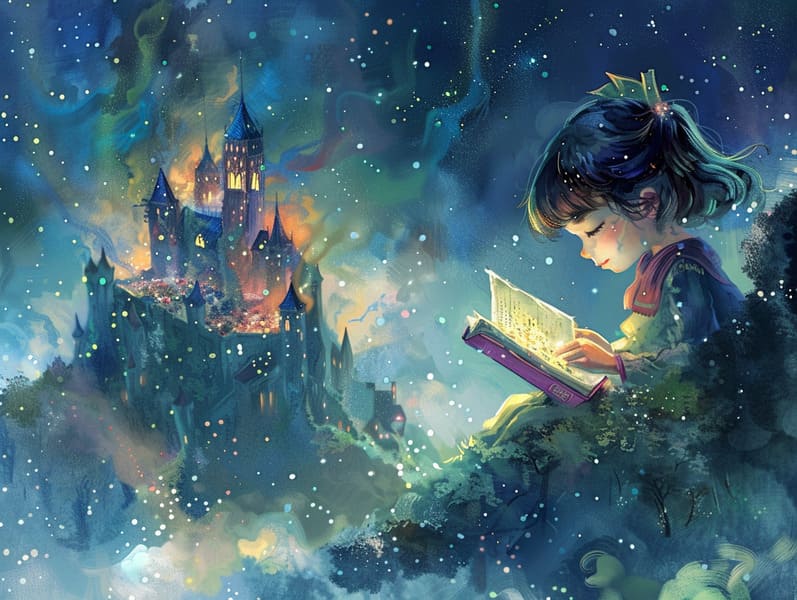
Best fairy tales have legendary status. These narratives have been whispered from one generation to the next long before they were ever documented. They emerged from a variety of traditions, including Asian traditions. They were initially narrated among adults, often carrying themes and messages related to the societal norms and beliefs of the time.
The famous Grimm duo, Jacob and Wilhelm Grimm, were among the first to collect and release many of these beloved tales. Their compilation, "Grimm's Folk Tales," included narratives like "Cinderella," "The Story of Hansel and Gretel," and "Snow White," which have since become cornerstones in the world of children's fairy tales. Similarly, Hans Andersen's delightful stories, such as "The Mermaid's Tale," and "The Duckling's Story," have touched hearts worldwide, guaranteeing their place in the pantheon of classic fairy tales.
Though they are centuries old, traditional fairy tales remain as pertinent as ever, especially as children's night stories. These charming stories are now available in multiple formats, including artistically illustrated books, whimsical animations, and free fairy tales online.
Their lasting presence can be linked to several charming aspects:
Valuable Lessons: Old fairy tales often convey important moral lessons. Fairy tales like "The Story of the Boy Who Cried Wolf" teach the value of being truthful, while "The Story of the Tortoise and the Hare" underline the merits of persistence and humility. These stories offer the young clear distinctions between right and wrong, forming their moral compass in a tender yet deep way.
Kindness and Comprehension: Classic fairy tales frequently portray beings facing tests and troubles, inspiring audiences to understand with their struggles and root for their triumphs. For instance, "Beauty and Her Beast" shows us the benefit of appreciating inner worth to know the inner self of a being, enhancing perception and knowledge.
Cultural Comprehension: Many classic fairy tales are steeped in the cultural contexts from which they came. Immersing in these tales can provide illuminating insights into different customs, strengthening a sense of international awareness and discernment.
Creativity and Fantasy: The fanciful elements in classic fairy tales—mythical entities—spark children’s innovative ideas. These stories guide readers to otherworldly realms, encouraging innovative ideas and a sense of awe that endures a lifetime.
Old fairy tales are not only captivating but also instructive. They serve as enchanted tools in building various cognitive and affective skills in young readers. When old fairy tales are told out loud, they promote speaking abilities by bringing new words and detailed sentence structures. This practice also advances auditory perception and mental focus, as the young stay focused, enthusiastic to see what happens next.
Furthermore, talking about the themes and characters of timeless fairy tales can strengthen thinking skills and analytical skills. Young readers are shown to spot patterns, make predictions, and get cause and effect. These contemplations also support young readers voice their thoughts and feelings, adding to their emotional intelligence.
In today’s information age, the presence of online fairy tales has made these narratives more attainable than ever. Websites and apps offer comprehensive collections of Grimm's fairy tales that can be viewed or listened through anytime, anywhere. Fairy tales recited are particularly sought after, making available an charming way for children to be a part of these whimsical stories. Read-aloud books and spoken videos bring characters and settings to life, often complemented by bewitching musical scores and soundtracks that heighten the narrative experience.
The unfading fascination of ancient fairy tales lies in their ability to adapt to the present while staying true to their underlying messages. Contemporary reimaginings of these narratives often feature more different protagonists and modern settings, making them pertinent to today’s audience. However, the central morals of courage, humanity, and equity remain unchanged, continuing to resonate with audiences of all ages.
Timeless fairy tales also offer a sense of calm and comprehensibility. They showcase a orderly narrative with a distinct beginning, middle, and end, often finishing with the ending of conflicts and the triumph of right over wrong. This dependability can be relieving for young readers, affording a sense of unchangeability in an variable world.
Timeless fairy tales continue to mesmerize and edify new generations, maintaining their beauty and pertinence in modern society. As kids' bedtime tales, they put out a perfect blend of fantasy and learning, encouraging moral values, empathy, and creativity. The presence of online fairy tales and the likability of fairy tales spoken warrant that these timeless stories remain acquirable to new generations.
By retaining and communicating these tales, we continue to glorify the rich tapestry of legends and cultural heritage. Whether you are accessing a richly illustrated book, delving into a web-based collection, or listening through an voice book, the attraction of ancient fairy tales is always within reach. These narratives demonstrate of the timeless influence of storytelling and its ability fairy tales to bind us across generations and cultures.
Be it you are browsing a beautifully illustrated book, viewing a digital library, or listening on an read-aloud story, the beauty of bedtime fairy tales is always within reach.
These tales show us of the endless spell of stories and its ability to bond us across epochs and places, weaving a spell that enchants and educates alike.